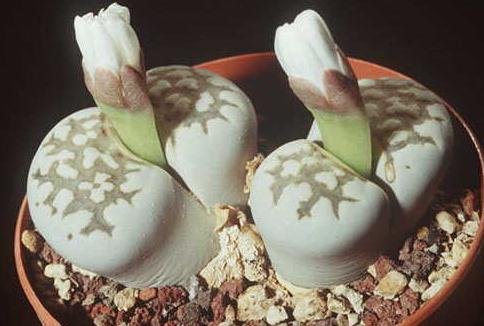- Lithops
Taxobox
name = "Lithops"

image_width = 208px
image_caption = "Lithops julii ". The structures emerging
between the leaves are flower buds
regnum =Plant ae
divisio = Magnoliophyta
classis =Magnoliopsida
ordo =Caryophyllales
familia =Aizoaceae
genus = "Lithops"
genus_authority = N.E.Br.
subdivision_ranks = Species
subdivision = See text."Lithops" is a
genus ofsucculent plant s native toAfrica , mainly inNamibia andSouth Africa . It is especially characteristic of theKaroo region at Africa's southern tip. "Lithos" means "stone" and "opsis" means "face" inAncient Greek ; therefore, "Lithops" means "stone-face". This is a very good description of these plants, which avoid being eaten by blending in with surrounding pebbles (camouflage ). They are often known as pebble plants or living stones. First description of lithops was made byWilliam John Burchell , explorer of South Africa, botanist and artist, who in1811 accidentally found a specimen when picking up from the ground a "colorful pebble". [cite book |last=Cole |first=Desmond |coauthors=Cole, Naureen |title=Lithops—Flowering Stones |publisher=Cactus & Co |year=2005 |isbn=88-900511-7-5]Individual plants usually have two bulbous, almost fused leaves opposite to each other and hardly any stem. The slit between the leaves contains the
meristem and producesflower s and new leaves. Old leaves die after the new pair has emerged. The leaves of the Lithops are transparent. These leaves, or “windows” contain calcium oxalate crystals that diffuse onto the area that is being photosynthesized in the Lithop. This helps the plant absorb lots of sunlight even in minimum exposure. The leaves of the Lithops are considered to be one of the leading plants with the most developed "window" leaves. Occasionally two new pairs emerge and plants can eventually form large clumps. The plant is almost entirely buried insoil , only exposing the flat upper surfaces of leaves. This is an adaptation to the dry, hot environment.Lithops are also gaining popularity as a
house plant .Seed s and plants are widely available in shops and over theInternet . They are relatively easy to grow, provided that they are not watered too generously and abundant light and heat are provided. Inwinter they should remain completely dry and temperature should be cooler. During the hot season, they like misting in the morning, but care must be taken lest they become too wet, or water droplets (which would serve as aburning-glass in direct sunlight) do not evaporate quickly enough.For import plants (which are rare but sometimes can be acquired on specialist sales), it must be remembered that the flowering and growing season is in the
Northern Hemisphere winter. Acquiring them in autumn and simply prolonging the resting period they are then in, maybe even not potting them, and providing them with fresh substrate in the spring as days become longer and sunnier is the easiest way to switch theircircannual rhythm."Lithops" thrive best in coarse, sandy substrate. They love rather shallow but comparatively wide pots, where the substrate does not become wet and clammy in the deep part easily; under such conditions, they will over the years grow to form large clumps. Propagation is not too easy for hobbyists; seeds are small and take a long time to grow, while cuttings (of plants that bifurcate) are very delicate and easily rot.
Species
Many of the species listed have a large number of varieties and regional forms. These should not be passed on without giving location information. they have different patterns on them.
External links
* [http://www.bbc.co.uk/dna/h2g2/A2654732 Lithops info from the BBC] ] (UK)
* [http://culturesheet.org/aizoaceae:lithops Lithops culture and care] on CultureSheet.org
* [http://www.lithops.info/en/cultivation.html A guide to the cultivation of Lithops]
* [http://www.lithops.info/en/books/literature.html Lithops books] and [http://www.lithops.info/en/links.html links]
* [http://www.lithops.info/en/gallery/images.html Lithops gallery]
* [http://s7.photobucket.com/albums/y257/dcaers/ Lithops photo album] (François Hoes, Belgium)
* [http://www.themountaingoats.net/lyrics/ahwtx_lyr.html#lithops: Absolute Lithops Effect] The Mountain Goats, from the album All Hail West TexasLiterature
*
*
*References
Wikimedia Foundation. 2010.
